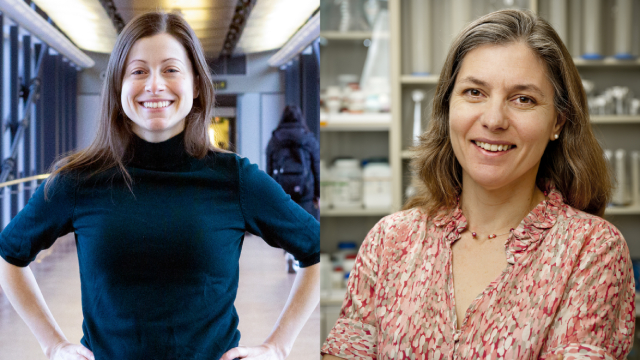Research
FoMD researchers take home 18 grants from NSERC
Ryan O'Byrne - 10 August 2020

Dr. Maria Ioannou (r) and Dr. Rachel Wevrick (l) were two of the 18 researchers from FoMD who recently received grant funding from the Natural Sciences and Engineering Research Council of Canada.
The projects, which range from improving the cryopreservation of aquatic species’ embryos to developing better MRI images, were awarded more than $3.2 million over the next five years as part of NSERC’s Discovery Grant program. According to NSERC, the program supports research projects with long-term goals, providing the kind of ongoing operating funding that can give researchers the flexibility to pursue the most interesting avenues of their research.
Led by Maria Ioannou from the Department of Physiology, one project that has received funding is “The regulation and function of lipid metabolism in astrocytes.” According to Ioannou, communication between neurons and astrocytes, one of the basic non-neuron cells in our brains and spinal cords, is integral to brain function. Her research project aims to uncover how fatty acid metabolism in astrocytes affects the activity of neurons, a process that is currently a mystery.
“I have always been interested in understanding how neurons and astrocytes communicate with
each other,” Ioannou said. “There are still a lot of unknowns regarding how the activity of these two cell types is coordinated. I think that fatty acid metabolism plays an important role in linking astrocytes to neuronal activity and I am very excited to receive an NSERC grant to pursue this research further.”
For Rachel Wevrick of the Department of Medical Genetics, the NSERC grant will help her continue to support undergraduate and graduate students who might otherwise not have had the opportunity to study in the natural sciences.
“This NSERC funding has enabled us to complement our research in the health sciences with fundamental research in natural sciences, amplifying the impact of both lines of research and cross-fertilizing discussions among my trainees and staff between these two complementary approaches to the study of rare genetic diseases causing neurodevelopmental disabilities,” Wevrick said.
Her project, “Biological functions of melanoma antigen (MAGE) proteins,” will explore how modification of proteins by ubiquitination and deubiquitination fine-tunes the activity of proteins in the cell. Ubiquitination is a modification process that helps to regulate the degradation of proteins, coordinate the localization of proteins in the cell, activate and inactivate proteins, and modulate protein-to-protein interactions.
Wevrick’s project builds upon previous research that found that melanoma antigen gene (MAGE) proteins regulate the ubiquitination and deubiquitination of proteins important to a variety of physiological processes, such as the body’s circadian rhythm.
The other projects to receive funding are (in alphabetical order):
- Jason Acker, Department of Laboratory Medicine and Pathology - “Enabling the cryopreservation of embryos from aquatic species using ice recrystallization inhibitors”
- Todd Alexander, Department of Pediatrics - “Molecular regulation of intestinal calcium absorption”
- Klaus Ballanyi, Department of Physiology - “Complex neuromodulatory processes in the locus coeruleus neuron-astrocyte network”
- Amit Bhavsar, Department of Medical Microbiology & Immunology - “Cross-kingdom platforms to study bacterial ubiquitin ligases in eukaryotic cells”
- Allen Chan, Department of Psychiatry - “An investigation of rest-stimulus interactions in mesoscale cortical networks”
- Nicola De Zanche, Department of Oncology - “Instrumentation and methods for magnetic resonance imaging”
- Gary Eitzen, Department of Cell Biology - “Regulation of immune cell vesicular traffic and exocytosis by Rho GTPases”
- David Evans, Department of Medical Microbiology & Immunology - “Gene acquisition by large DNA viruses”
- Larry Fliegel, Department of Biochemistry - “Mechanism of plasma membrane mediated Na+/H+ exchange and salt tolerance in plants, animals and yeast”
- Gregory Funk, Department of Physiology - “Information processing by respiratory motoneurons”
- Armin Gamper, Department of Oncology - “Functional characterization of apical kinases in the cellular stress response”
- James Hammond, Department of Pharmacology - “Posttranslational regulation of the SLC29A family of nucleoside transporters”
- Marcelo Marcet-Palacios, Department of Medicine - “Differential expression and processing of CABS1 across tissues and fluids and its location-specific functions”
- Evangelos Michelakis, Department of Medicine - “A novel, non-canonical mechanism for the nuclear entry of large mitochondrial enzymes”
- Peter Nguyen, Department of Physiology - “Regulation of synaptic plasticity by the cyclic-AMP signalling pathway”
- Boguslaw Tomanek, Department of Oncology - “Permanent magnet for ‘gradient-free’ MRI”